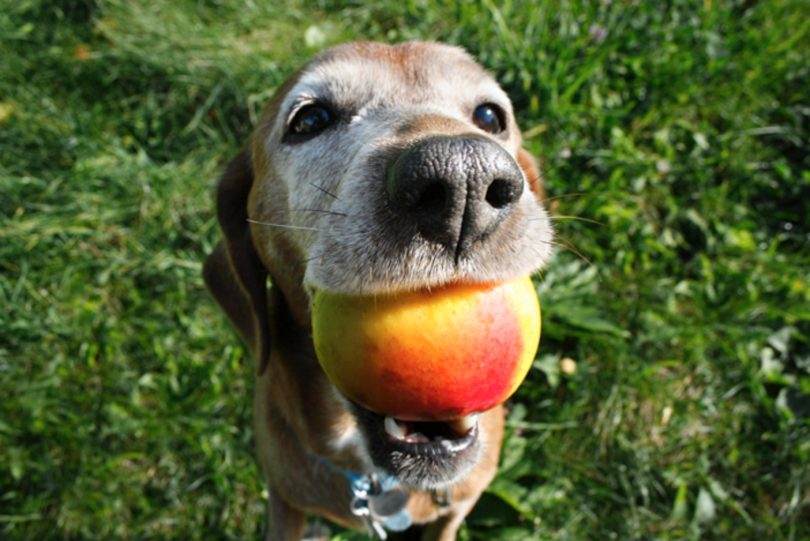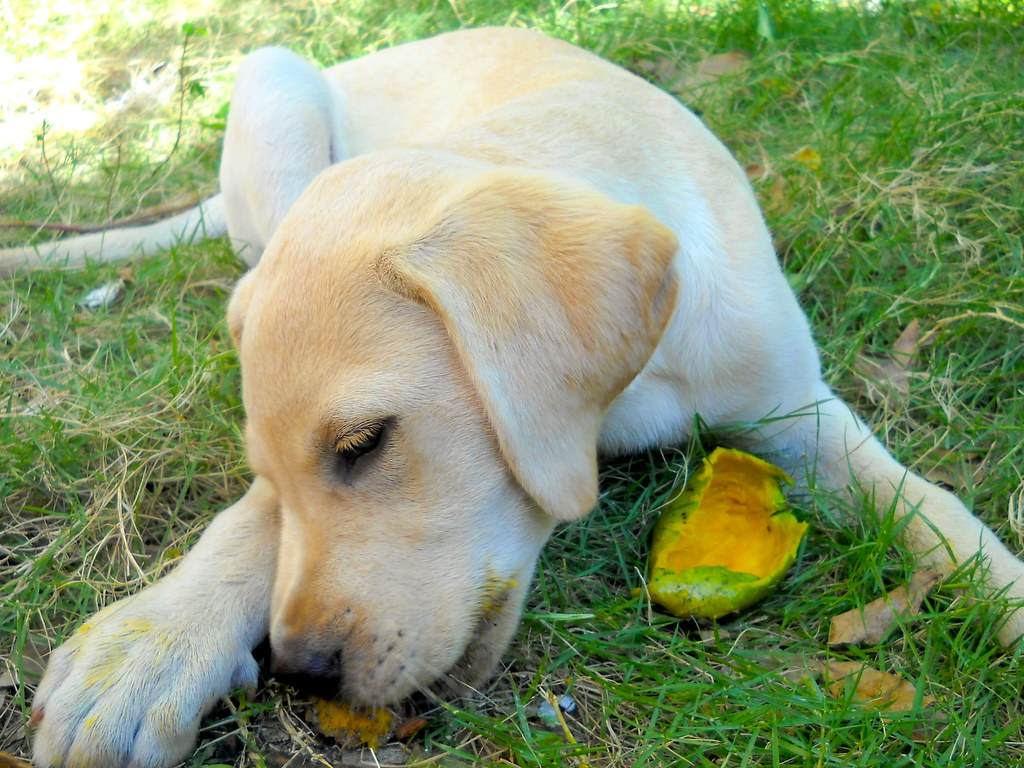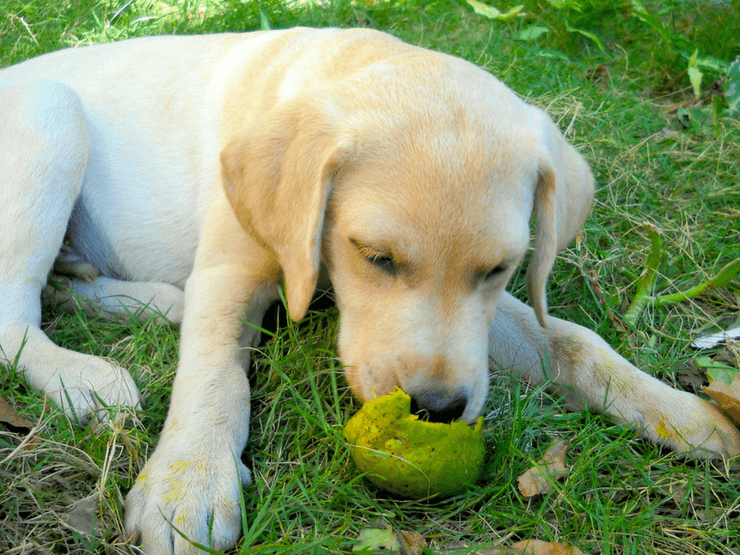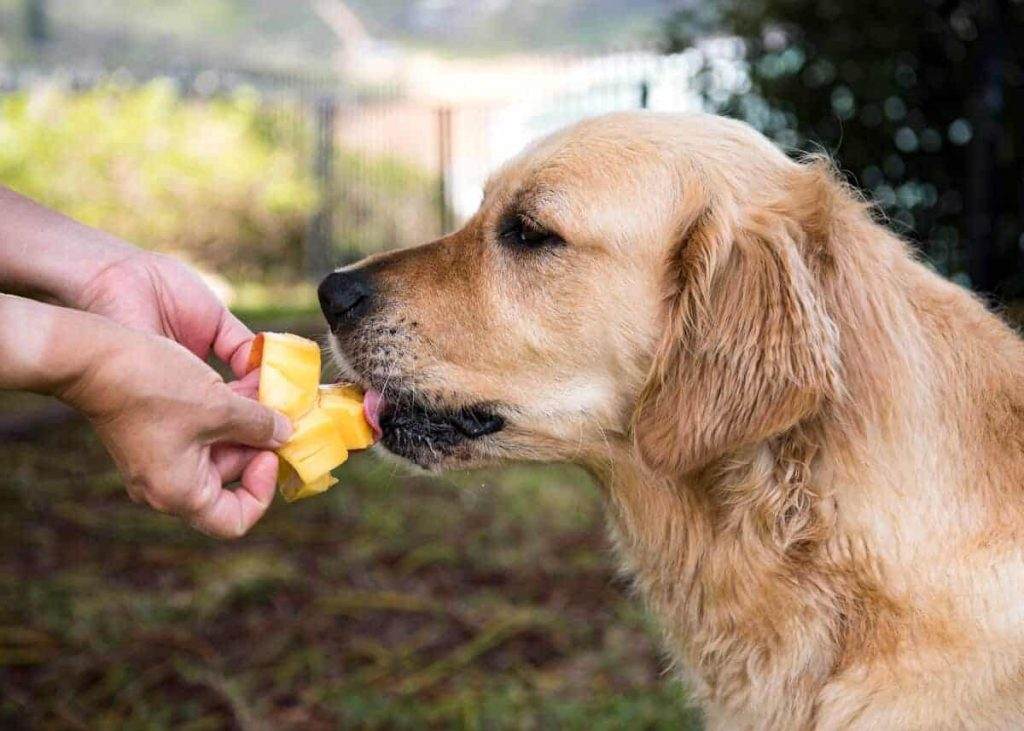
A well-balanced, nutrient-rich diet is essential for your pooch. Your dog’s diet is mainly comprised of proteins and fats. You may often wonder if human foods are suited for your dog. Fruits can be important sources of vitamins and minerals for dogs. However, not all fruits are suitable for the consumption of your pooch. Some fruits may also be toxic for their health.
Many dog owners are worried about choosing the right fruits for their furry friends. One such common query is about mangoes- you may have often wondered if mangoes are safe for your dog. The answer to this question lies ahead.
Are Mangoes Safe For My Dog?
The answer to this question is yes, mangoes are safe for your dog. They make delicious sweet treats for your furry friend. However, not all parts of a mango are suitable for consumption.
The pit and peel of a mango must never be fed to your dog. Apart from that, mangoes are excellent sources of vitamins that improve your dog’s health. The best way to feed your dog a mango is to peel it and remove the pit. The ripe mango may also be cut into smaller pieces to ease consumption.

Although mangoes are non-toxic for your pooch, there are certain precautions you keep in mind. Mangoes may lead to certain issues in your dog’s dental health, digestive system and glucose levels.
Hence, mangoes should remain an occasional treat for your pooch rather than a permanent addition to its diet. Let us go through both the benefits as well as probable issues with the consumption of mangoes.
Health Benefits of Mangoes

Mangoes are sweet, fleshy chewy treats that are filled with nutrient-rich goodness. They are rich sources of vitamin A, B6, C and E. Vitamin A is good for bone development and for building your dog’s immunity. Vitamin C helps also helps cure ailments and boosts your pooch’s immunity resistance.
Potassium and vitamin K are also part of the nutrients supplied by mangoes. Potassium is important for maintaining a healthy circulatory, renal and nervous system. Vitamin K boosts the clotting factor in your dog. Mangoes are rich in minerals as well.
Mangoes are important sources of antioxidants that are good for maintaining healthy eyesight. They can be served to your pooch at room temperature or as delicious frozen treats.
To avoid any possible health complications associated with the consumption of mangoes it is best to ask your vet about the appropriate amounts of the fruit vis-à-vis your dog’s age and breed.
Concerns with Mango Consumption
Although overall, mangoes are non-toxic and healthy for your furry friend, there are certain possible health risks you should keep in mind.

- Firstly, the peel of the mango needs to be removed before serving it to your dog. Although dogs can chew through the skin of a mango and it is technically edible, the peel contains excessive fibers that may lead to digestive issues if ingested by your pooch. Intestinal blockages can be caused due to improperly chewed mango peels. It is best to avoid the peel.
- Similarly, the pit of a mango must always be removed. It is a potent choking hazard for your pooch. Some pits are known to contain traces of cyanide and hence must be actively avoided. But more commonly, it can cause digestive blockages in your pooch if ingested. It is best to avoid the pit. If your dog accidentally swallows the pit, make sure that it is passed out later. If you witness any difference in your dog’s eating behavior after he swallows the pit, consult with the vet immediately. Your dog may experience vomiting, abdominal tenderness, lethargy due to obstruction caused by the mango pit. Changes in your dog’s behavior may also be signs of this obstruction. Increased growling or biting when touched around the abdomen are signs of obstruction and this must be treated instantly.
- The third important possible health issue is that eating mangoes in large amounts or on a regular basis can lead to digestive issues. Their fibrous character affects your dog’s sensitive digestive system. Your dog may experience diarrhea and other stomach problems if he is fed fruits like mangoes daily. Excessive and regular consumption of fruits may be unsuitable for your dog. You can ration the consumption of mangoes in your pooch to avoid possible stomach problems.
- The sweetness of the mango can be a causal factor in accelerating dental decay in your pooch. A whole mango is said to have around 46 grams of sugar, which can be problematic for your furry friend when consumed daily. Excessive sugar can lead to diabetes in your dog by increasing his blood glucose levels. High sugar diets can also cause heart problems in dogs.
What Happens If Your Dog Accidently Ingests a Mango Pit?
In this case, you should wait for it to pass out naturally. If this does not happen and you start witnessing some of the symptoms listed above, you should consult the vet immediately.
A mango pit can cause serious intestinal blockages that may require surgery to be cleared. Alternatively, they can also cause cyanide poisoning which needs to be immediately treated with intravenous medication.
Best Ways to Feed Mangoes to Your Dog

The best way to feed your dog a mango is to peel it and remove the pit, then you may slice it to help avoid choking. You can avoid slicing the mango depending on the size of your dog.
Larger dogs can eat the soft fleshy mango easily, however for smaller ones, slicing it into pieces before serving is recommended. You can simply store the sliced pieces instead of serving them immediately. Your dog will also love them as frozen treats during the summer months.
Dehydrated Mango Treats

Mangoes can also be dehydrated and stored for delayed consumption. Mangoes can be combined with other treats to be made into a wonderful dehydrated snacks. They can be stored for quite some time in this dehydrated form.
Dehydrating mangoes is quite simple with an electronic dehydrator. If you do not have a dehydrator, the same effect can be achieved with the lowest setting on your oven. The only catch here is that you will have to keep an eye on the mango slices, to prevent them from burning.
For a dehydrator, the fruit needs to be sliced into really thin slices to make the process of dehydration faster. If the slices are thick, dehydration will take longer. The thicker slices take about 10-12 hours to dehydrate completely. The mango slices need to be then soaked in a lemon water bath. Then the dehydrator works its magic on the slices.
You simply have to pat the slices dry, after removing them from the lemon water bath and place them on the dehydrator tray. Make sure that the slices don’t overlap. Set the dehydrator at 130 degrees and wait for the miracle. In the next 4 hours, your dehydrated mango slices will be ready.
The crispier the mango slices, the longer they will last, thus, make sure you have crispy slices especially if you plan to use these as on-the-go treats. These crispy treats last up to 2 weeks in an airtight container.
However, an area of concern with dehydrated mangoes is that they have a relatively high level of sugar concentration than fresh mangoes.

In whichever way you decide to serve mangoes to your pooch, it is always advisable to first consult the vet about the right quantity of the fruit for your dog.
The vet may also help you develop a schedule for feeding your dog this nutritious fruit as he is aware of your dog’s health parameters. It is also advised to keep treats to a minimum. A well-balanced approach is helpful. Feed your dog treats but in a regulated way.
Treats should not exceed 10% of his total calorie intake. The rest should come from his nutrient-rich, healthy, age-appropriate dog food. A dog parent must devise an effective routine to find a balanced approach.
Should I Feed My Dog Mangoes?

The final answer to this question is yes, but with the much needed precautionary measures. The first step to feeding your dog mangoes will be to consult the vet to determine the best routine for administering mangoes. He will be able to ascertain this based on your dog’s diet, health, exercise routine, age and weight.
You then need to be careful about eliminating the peel and pit of a mango. Slice the mango if your dog is small to avoid choking. You can use dehydrated mangoes as treats during training sessions. This will also improve your dog’s interest in training.
The key to feeding your dog mangoes or any other non-toxic fruit is to ration its quantities and dosages of administration. This is because an excessively fibrous diet can lead to health issues in your pooch. Follow the principle of moderation and be rest assured that your pooch will enjoy his happy sweet treats without any ailments.
Table of Contents



